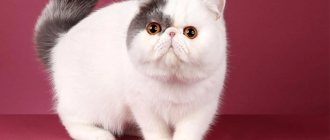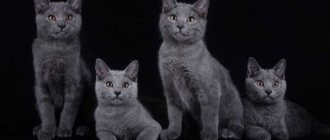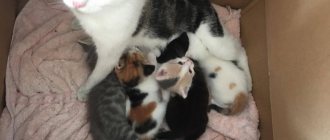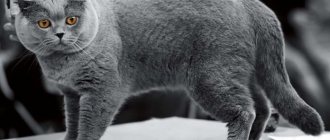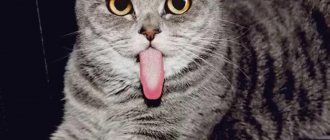History of the breed
Disputes between felinologists in Europe and America about the roots of this breed have not subsided to this day. According to TICA, the largest and most influential American international felinological system, which still recognizes the Javanese as a type of Balinese cat and does not distinguish them as a separate breed, their homeland is North America. In 1979, Canadian breeders Maurice Davis and Edd Sender set out to breed a new type of Balinese.
The typical Balinese cat has a color-point or Siamese coloring and is essentially a Siamese with long hair. Canadian felinologists set out to obtain animals of other colors - red, cream, tortoiseshell, tabby, tortie. This variety of Balinese was named Javanese, considering that if Bali and Java are neighboring islands, then such similar cats could bear their names.
In Great Britain, in the seventies of the last century, a similar animal was obtained by crossing an Abyssinian Sorel color and a Sial Point Siamese. The British named the new specimen the British Angora. But the name did not take root, since these animals have nothing to do with the Turkish Angora. The new breed was given the name Java cat. However, this only added to the confusion - after all, there is already such a breed in the United States.
This is how two types of Javanese were formed: American and European. European felinological associations such as WCF and FIFe consider the Javanese to be an oriental type cat with medium-long hair and a variety of colors.
The Javanese, recognized as a breed by some American systems (CFA, ACFA, CFF), but not by TICA, is a variety
Balinese cat with any colors except Siamese. TICA does not classify the Javanese as a separate breed, but continues to consider it a variety of the Balinese cat.
In Russia it is generally accepted that the Javanese cat can have any color typical of the shorthaired Oriental. But this breed is very rare in our country.
Oriental cat
Javanese breed character
Javanese, like all oriental cats, are lively, intelligent, playful and sociable. Many of them love to bring a ball or toy thrown by their owner over and over again. Each of them has their own favorite toys: one loves rattling mice, the second loves paper balls, the third loves soft toys. They can have fun with an empty cardboard box for hours. And they never stop playing: even in old age, the Javanese remains a little kitten at heart. Some of them are born steeplejacks, others love high jumps, and don’t feed others bread, let them explore the narrowest crevices and dark corners.
Many Javanese love to talk with the owner or comment on any of his actions. They are strong and intelligent individuals. Don't let the sophisticated appearance fool you. The Javanese is a muscular, confident cat with a plume tail held high. Most often, it is these elegant individuals who become the main ones in the house, subjugating other cats, dogs and even owners!
Javanese dogs love their owners very much and need constant communication with them. Some of them, of course, may give preference to one particular family member, but mostly they prefer large companies, when they have the opportunity to jump from one knee to another, purr and receive maximum attention and affection. They always try to be the center of attention, sleep under the owner's blanket, in a crib or with other animals. They begin to feel sad if they receive little attention. Javanese are the cat for people who want a sociable and funny companion cat, not a silent couch cushion with eyes.
Description and breed standard
Characteristics and description of the American-type Javanese cat breed is given by the CFF system:
- Head. A narrow wedge, small in size, proportional to the body. In profile - a strict straight plane from the forehead to the nose, without deflections or bulges.
- Neck. Long, thin and graceful, but muscular and well developed.
- Eyes. Medium size, almond-shaped, oriental cut. The location is ok. Color - bright blue for white colors, green for all others.
- Ears. Large, wide at the base, tapering towards the tips. Continue the wedge of the head.
- Nose. Long and narrow, absolutely straight.
- Body. Medium size, long and thin, rather lean with well-developed muscles. Shoulders and hips are the same width. The abdomen is tucked up.
- Paws. Long, slender, muscular. The rear ones are slightly higher than the front ones.
- Tail. Long, thin, flexible, strongly tapering towards the end, evenly pubescent in a “plume” type.
- Wool. Medium length, fine hair, no undercoat. The tail is the most heavily furred.
- Colors. Any.
- Weight. Graceful animals of medium size from three to five kilograms.
Disqualifying signs:
- Spots and stripes in all colors except tabby and tortie
- Tail creases
- Strabismus, other eye defects
- Amber eye color.
Oriental cats
Oriental cats define several species native to Asian regions. The Javanese is classified in the order “Oriental cats” or “oriental” cats. The breeding of the distant ancestors of the Javanese cat began in Thailand in the 15th century (at that time Thailand was called Siam).
Orientals, as they are called, were the result of crossing Siamese cats with certain European species. However, these seals received official recognition not so long ago. The appearance of Orientals was different from other breeds, so Europeans did not immediately recognize these cats. The breed began to be imported to Europe only in the middle of the last century; the first country in which oriental cats appeared was England. Then the demand for them arose in America.
In Russia, graceful handsome men have become widespread since the 60s of the twentieth century. Individuals are distinguished by their unusual appearance, habits and relatively docile character. Scientists also consider oriental breeds such as the Bengal, Sumatran, spotted red cat, fishing cat, etc., although they are somewhat different in appearance from the classic orientals.
Variety of colors
If the Balinese cat has only color-point color in various color modifications, the Javanese is famous for its wide variety of colors:
- Red - bright red evenly. The nose and pads are bright pink.
- Lilac or lavender. Plain gray with a pink tint. The nose and paw pads are pink.
- Blue. Uniformly gray with a blue tint. The nose and paw pads are gray-pink.
- Cream. Pale red, pastel, nose and paws pale pink.
- Chocolate or Havana. Intense brown evenly throughout the entire coat, with a red tint. The nose and paw pads are pink with a brown tint.
- Ebony is completely black, including the nose and paw pads.
- The Faun is a uniformly pale beige with pink paw pads and nose.
- Cinnamon is pale brown with a chestnut tint.
- White - snowy white, a very pure color, without a tint of beige or blue. The paw pads and nose are soft pink. The only solid color with blue eyes.
- Tabby - marbled, brindle, tortoiseshell (tortie), ticked, silver.
- Bicolors - party color (one-color tone with spots), color point (Siamese), tortoiseshell (tortie), smoky (ticked).
Health and care
Javanese cat
Since the Javanese kitten does not complain about activity, it most likely draws vitamin B from the body. To avoid this, it is recommended to add 1⁄4-1/8 teaspoon of brewer’s yeast to its food. You can also feed him food rich in zinc and amino acids, this will add beauty to the coat. In the overall picture, the diet of the Javanese cat is practically no different from other cats.
Also read: Pixiebob cat
They do not require special coat care; brushing once a week is enough, since their fur coat is thin. Eyes and ears should be cleaned only when necessary. Teeth should be brushed once, or even more often, a week. The average lifespan of a javanese is about 15 years .
Color
You can distinguish a Javanese cat from a Balinese only by its point colors; these are their main differences. The coat color of the Javanese can be as follows:
- The nose is pink, the color is red.
- The nose is beige, cinnamon colored.
- The nose is pink, the color is cream.
- The nose is light pink, fawn color. You can see what the Javanese cat breed looks like in the following photos; the photo does not show all the colors that this cat breed has.
The price for this breed starts from $400 and can easily exceed $2000, much will depend on the chosen class.
Share with friends:
MisterCat recommends: Characteristics of temperament
The Javanese is a pet that should absolutely not be purchased if the owners do not have the opportunity to spend most of their time at home. Absolutely cannot stand loneliness. Very attached to a person, pathologically jealous and touchy.
Javanese will be able to get along with other pets, provided that the acquaintance was carried out correctly and carefully. But the owner’s attention is the main thing for him. And this pet will not tolerate a subordinate position; he must always lead in everything.
This cat will have a hard time in a small area, he loves to run and play. He can clean up a mess in no time. He needs a lot of different toys; it might be worth purchasing a simulator. The ideal place for Javaneza to live is a country house with a paddock in the backyard.
But such a difficult temperament is completely balanced by the dog’s devotion and boundless love for humans. If you are accustomed to wearing a harness from an early age, he will be happy to walk on a leash.
Health
The Javanese inherited not very good health from his Siamese ancestors. He is susceptible to some infectious diseases, does not like the cold and often suffers from eating disorders. Javanese also has problems with the nervous and cardiovascular systems. These cats are also susceptible to colds and strabismus.
Neurological disorders
Javanese may be subject to the following disorders:
- epilepsy. It can manifest itself in a cat either very intensely or with rare seizures. The cause of the disease is a dysfunction of the nerves of the brain. The cat suddenly loses consciousness or stares at one point. Convulsive muscle contractions may also occur. Epilepsy has no cure, but can be relieved with anticonvulsant medications;
- myasthenia gravis. It can be inherited and acquired. It manifests itself as muscle weakness as a result of disruption of the passage of nerve impulses. Treatment involves the use of AChE inhibitors, prednisolone and pyridostigmine bromide. Surgery may also be required.
Javanese may suffer from nervous disorders
Hyperthyroidism
Hyperthyroidism is a disease of the thyroid gland. It produces too much thyroxine. Hyperthyroidism may present with tremors, ventral neck flexion, and muscle pain. Corticosteroids or potassium supplements may be prescribed for treatment.
Table: symptoms of hyperthyroidism
| Symptom | Frequency of occurrence |
| Weight loss | 90% |
| Increase food intake | 53% |
| Vomit | 44% |
| Increased water consumption and frequent urination | 40% |
| Increased activity, changes in behavior, nervousness | 34% |
| Untidy fur and hair loss | 30% |
| Diarrhea | 20% |
| Tremor (shivering) | 15% |
| Lethargy | 13% |
| Dyspnea | 12% |
| Decreased activity | 12% |
| Loss of appetite | 7% |
Amyloidosis
Amyloidosis is a genetic disease that occurs due to the amyloid protein, which “settles” in an organ (in cats it is the pancreas, spleen, kidneys and liver) and causes its damage. Its symptoms:
- With renal amyloidosis, the urine takes on the appearance of blood plasma, and the cat may develop anorexia. You may also experience extreme thirst and frequent urination. Ascites (edema of the abdominal cavity) often develops;
- with hepatic amyloidosis, apathy, lack of appetite and sudden weight loss are most pronounced;
- general symptoms are deterioration of the coat, diarrhea alternating with constipation, icteric mucous membranes and skin.
The disease is incurable and can only be alleviated in the early stages.
Asthma
Asthma is a very dangerous attack-like disease of the respiratory tract. It manifests itself as a spasm of the bronchi, making breathing difficult. It cannot be cured, you can only alleviate its course. Very often, asthma can be confused with pulmonary and heart failure, infection with parasites, bronchitis, tumors and pneumonia.
Symptoms of asthma include:
- frequent attacks of suffocation;
- wheezing;
- sniffling;
- open mouth breathing;
- coughing;
- the pet sits with its neck constantly stretched out;
- in severe cases, the cat suddenly falls, wheezes heavily, and does not respond to the owner. All this is accompanied by blueness of the mucous membranes.
Treatment boils down to taking medications, using inhalers for attacks and following the veterinarian’s instructions, as well as humidifying the air in the room, daily wet cleaning, minimizing contact with chemicals, etc.
Care and education
Caring for this pet is not at all difficult. The coat is of medium length, but without undercoat. Brushing is enough once a week; the Javanese loves this procedure. There is no need for frequent washing; bathing twice a year is enough.
It is necessary to keep your teeth, eyes and ears clean, brushing them once a week.
The Javanese are intelligent creatures. If from an early age they are accustomed to the litter box and scratching post, then there are no problems with maintenance.
Character traits
For those people who love quiet and calm pets, it is not recommended to have active and active Javanese cats . After all, like their distant ancestor the Siamese cat, these wayward and playful animals require a lot of attention. In addition, the Javanese cat's character is characterized by extreme determination and stubbornness. These sophisticated creatures will achieve what they want at any cost, despite all the owner’s prohibitions.
Javanese cat kittens can play and frolic all day long, without wasting time on such trifles as eating or sleeping. All owners of these charming, mischievous babies claim that their pets are capable of turning the entire apartment upside down in a matter of minutes. Even after growing up, these cats retain the ability and love for active and active games, and at a very old age they can behave like little playful kittens.
You need to provide your pets with a wide variety of toys, otherwise the Javanese cat will turn any small object he likes into his favorite toy. For the same reason, it is advisable to hide all jewelry and valuables in places inaccessible to the cat.
It should be noted that these cats are distinguished by their extraordinary jumping ability and can easily climb the highest shelf or surface of a cabinet, so it is useless to hide anything there from cats.
These breeds get along well with other pets. Sometimes, due to their playful and active nature, they can start noisy fights with other cats, but owners should not worry about this, their pets will make peace pretty quickly, and within an hour they will be sleeping peacefully in an embrace on the same sofa.
Health, proper nutrition
After weaning kittens from their mother, it is better to gradually transfer them to super-premium dry ready-made food. It is possible to feed natural products, but it is very difficult in modern conditions and requires additional inclusion of vitamins, macro and microelements in the diet.
Like many breeds obtained by crossing domestic species, they are prone to a number of chronic diseases:
- Amyloidosis
- Cardiomyopathy
- Bronchial asthma
- Diseases of the gastrointestinal tract and nervous system.
Due to their belonging to the oriental cat breeds, birth defects are common - squints and broken tails. In order to detect the disease in time and help your pet, it is necessary to monitor the animal’s health and contact a veterinary clinic in a timely manner.
Javanese cat nutrition
Javanese is quite unpretentious in terms of nutrition. But in any case, it is better to feed your cat the highest quality premium, super premium and holistic food. You cannot feed color-point Javanese fish with fish food - this will darken their fur.
Industrial feed
Among the best foods for javanese are:
- Royal Canin Indoor for long-haired cats (premium, France);
- Acana Grasslands (holistic, Canada);
- Summit Original Indoor Cat Recipe (super premium, Canada);
- Bosch Sanabelle Adult (super premium, UK);
- Fitmin For Life Hairball (super premium, Czech Republic);
- Go! Natural Chicken, Turkey + Duck Recipe (holistic, Canada).
Suitable for kittens:
- Wahre Liebe Junge - up to 4 months;
- Orijen Cat&Kittens - from 2 months;
- Royal Canin Kitten - dry and wet food for kittens from 2 months to one year;
- Brit Premium Kitten - from 2 months;
- 1st Choice Healthy start.
Photo gallery: food for javanese
Royal Canin Indoor contains easily digestible proteins and is designed specifically for indoor cats. Acana uses ingredients grown in the Alberta region to produce its food.
Bosch Sanabelle food is produced under the control of independent laboratories Fitmin For Life Hairball food helps fight hairballs
Food from Go! allows you to prevent and treat many diseases Wahre Liebe is a German company that produces high-quality and easily digestible food Orijen produces grain-free food with a high protein content
Brit Premium Kitten - Czech food for kittens, produced in dry and wet versions Summit Original Indoor Cat Recipe - food produced on the company's own farms, which guarantees its high quality Royal Canin wet food for kittens has a balanced composition and contains everything necessary for growing body substances and microelements 1st Choice Healthy start - an excellent option for starting complementary feeding
Natural nutrition
Natural food cannot be mixed with industrial feed. This diet is based on meat as the main source of essential amino acids. The menu can include:
- beef (offal, muscle tissue);
- chicken meat;
- porridge (rice, buckwheat, oatmeal);
- vegetables and herbs, except potatoes, onions and spices;
- cottage cheese, medium-fat kefir, yogurt;
- raw eggs.
Protein should not make up more than 60% of the daily diet, as excess meat can change the color of the Javanese cat to a darker one. 20–30% of the diet is fat. You can add egg yolk, butter, vegetable oil, and chicken fat to cat food. The remaining 10–20% of the diet is carbohydrates. Javanese can eat boiled bran, rice and oatmeal, but in small quantities. The animal will receive vitamins from vegetables, calcium and other important substances - from cottage cheese, yogurt and kefir, which are given 100-150 g per week, divided into 3-4 doses.
Cottage cheese for cats should not be fatty, salty or sweet
A Javanese cat needs at least 100 and no more than 200 g of natural food per day.
From these products you can create a menu for Javanese. It might look like this:
- Breakfast - rice with beef and vegetable puree. The products must be boiled and mixed with each other.
- Dinner - raw chicken, oatmeal, vegetable puree and egg yolk. Boil the flakes, chop the meat finely, boil the egg and separate the white from the yolk. Mix all ingredients thoroughly. The evening reception should be less than the morning one.
Also don't forget about vitamin supplements:
- 8 in 1 Excel Brewer's Yeast (brewer's yeast);
- Beaphar Kitty's Mix;
- AniVital FeliDerm;
- Polidex Immunity up;
- Agrovetzaschita Radostin.
Vitamins are an important part of a cat's diet.
Kitten price
Javanese is a very rare animal in our country. Perhaps it can be found in some Siamese nurseries. The price of a pet-class kitten (as a pet) is from twenty to forty thousand rubles.
For breeding and exhibitions, it is better to purchase a Javanese cat from nurseries in the USA, Canada or the UK. In this case, the cost of the animal will be more than one and a half thousand dollars.
A small photo gallery of Javanese cats:
At what price can you buy a Javanese kitten?
Javanese cats in Russia are only available in registered catteries. The parents of such kittens must have a pedigree and titles or a diploma from an exhibition, which must have a score of at least EX-1. Breeders of this rare breed will be happy to share with buyers the exhibition achievements of their pets, they can show a certificate of registration of the nursery, and pedigrees of the kittens’ parents. If you are told that there are no documents, then this means that you are dealing with a deceiver whose cats cannot be considered Javanese.
Javanese, as a work of art, is an exclusive creation.
How to choose a kitten
When choosing a kitten, you should carefully examine it: its eyes and ears should be clean, its teeth should be white, and the baby should not show anxiety when its tummy is touched. Pay attention to the activity of the javanese - the cat must be active and play.
Check your pet's hearing – it is among Javanese cats that kittens with hearing impairments are often born. Suitable age for purchase is 3-4 months. Such a cat will easily get used to its new home and owners, and it will be easier for you to establish contact.
If you decide to have offspring with a Javanese, try to choose your partner carefully. The animal must meet all accepted parameters, have no congenital or genetic diseases, and be vaccinated. The age of cats is at least 2 years, males - 1.5 years.
Mating of Javanese is carried out in the place where the cat lives. Try to ensure that the cat brings kittens no more often than once every 1.5-2 years, otherwise the animal itself will weaken, which will negatively affect the offspring.
The Javanese cat is a devoted, loving creature; with proper care and feeding, the pet can live up to 15 years, delighting you with affection and purring.
Nutrition
The main place in caring for a Javanese cat should be given to the selection of diet. Feed your cat balanced dry food and premium canned food (pedigree cats have sensitive digestion).
The food should be fractional, calculate the norm based on the cat’s weight - up to 50 grams per kilogram of weight, food - at room temperature. Give vitamin-mineral supplements and always leave clean water in the bowl. If you decide to introduce natural products into your diet, opt for meat (except pork) and poultry. Fish is allowed in small quantities, only sea fish and boiled without salt.
Buy Javanese kittens from specialized nurseries or from professional breeders, so you will receive a pure individual that fully meets the standards. The cost of a Javanese cat is higher than that of a cat. Purely expressed pets, whose parameters correspond to the exhibition ones, are estimated from one hundred thousand rubles. Javanese with defects is much cheaper, but, of course, it is not suitable for breeding offspring.
